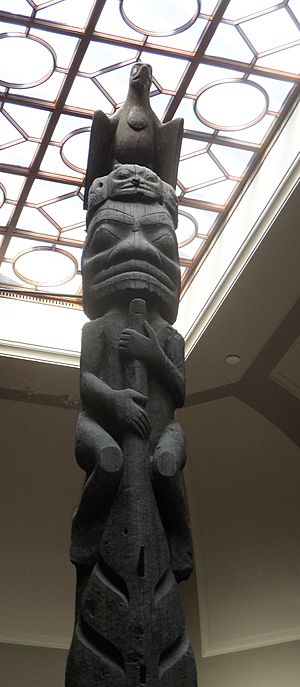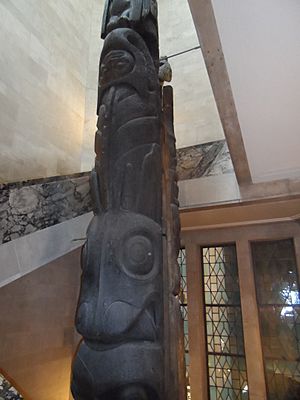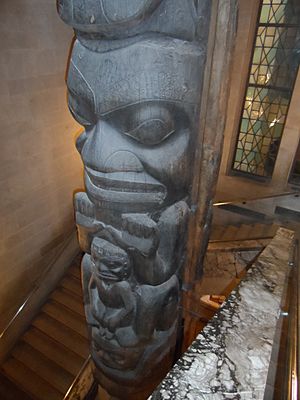Nisga'a and Haida Crest Poles of the Royal Ontario Museum facts for kids
The Nisga'a and Haida Crest Poles of the Royal Ontario Museum are amazing tall wooden poles. They were carved by hand from special cedar trees. These poles were made by the Nisga’a people and Haida people who live on the coast of British Columbia.
There are four main poles in this collection:
- Three Persons Along (Nisga'a)
- the Pole of Sag̱aw̓een (Nisga'a)
- the Shaking Pole of Kw’ax̱suu (Nisga'a)
- House 16: Strong House Pole (Haida)
Each of these crest poles tells a family story. The carved figures on them show important family symbols, called "crests." These crests help remember family history, like where they came from, what they achieved, and their special experiences. These memorial poles were usually placed in front of the owner's house, right along the beach.
The Nisga'a crest poles were bought by C.M. Barbeau. The Royal Ontario Museum got them in the early 1920s. The poles were so big that the museum couldn't show them right away. They had to wait until 1933, when the museum building was made bigger and built around them!
The Pole of Sag̱aw̓een is the biggest of the four crest poles. It stands over 24.5 metres (80 ft) (about 80 feet) tall! It's the tallest known pole from the 1800s. You can find these poles at the Royal Ontario Museum. They are just outside the Daphne Cockwell Gallery of Canada: First Peoples. The museum's main staircase winds around them, making them a "must-see" part of the museum.
Contents
Three Persons Along (Nisga'a)
Three Persons Along is a special pole made to remember someone important. It was carved by Axts'ip, who was part of the Fireweed clan. This pole honors Chief Ksim Xsaan from the Raven Tribe. Even though it doesn't have a specific name, people call it Three Persons Along. This is because of the three human figures carved one above the other on the pole.
This pole was put up in 1860 and is made from cedar wood. It originally came from the village of Gitlaxt’aamiks in British Columbia. It was cut down in 1918 and later sold to the Royal Ontario Museum. The pole is 10 metres (33 ft) (about 33 feet) high.
The figures on this pole, from top to bottom, are:
- Person of Lizards
- Person of Lizards
- Person holding Flying Frog
These figures show creatures that lived in a shallow lake. This lake was east of the village of Gitwinksihlkw. A volcanic eruption in the 1700s covered the lake with lava, so it's gone now. Where the lake used to be, there is now the Nisga'a Memorial Lava Bed Provincial Park.
Three Persons Along is one of only three complete poles saved from the village of Gitlaxt’aamiks. There were 24 poles there, but most were destroyed in the early 1900s.
Pole of Sag̱aw̓een (Nisga'a)
The Pole of Sag̱aw̓een was carved by Oyee. It was made to honor Chief Sag̱aw̓een from the Eagle tribe. This pole is 81 feet (25 m) (about 24.7 meters) tall. It is the tallest pole ever carved on the Nass River. It stood in the village of Gitiks. Two other Eagle poles were also there: the Eagle's Nest Pole, and later, the Halibut Pole of Laay.
The figures carved on this pole, from top to bottom, are:
- Eagle (a separate piece)
- Man Underneath
- Shark
- Wooden man named Uwait
- Dragonfly
- Bullhead
- Man named Aitl
- Man named Gunas
- Eagle
- Halibut
- Uncle of Gunas
- Cormorant (a separate piece)
- Aitl and the Devil Fish
Shaking Pole of Kw’ax̱suu (Nisga'a)
The Shaking Pole was one of several poles on the beach along the Nass River. Its name comes from the idea that grizzly bears would shake the pole as they climbed it. Two carvers, Oyee and Yarogwanows, created this pole. It is 45 feet (14 m) (about 13.7 meters) tall and was put up in the 1840s. This memorial pole honors a female chief named Kw'axsuu.
The figures on the pole, from top to bottom, are:
- Prince of Grizzlies
- Bear Mother
- Hanging Across
- Ensnared Grizzly
- Real Kingfisher (also called Submerged Person)
- Running Backwards (this part was later removed)
What's special about this pole is that it shows symbols from two different tribes: Wolf and Raven. The top four figures (Prince of Grizzlies, Bear Mother, Hanging Across, and Running Backwards) are from the Wolf tribe. The bottom two figures (Real Kingfisher and Running Backwards) are from the Raven tribe. Chief Kw'axsuu wanted both her mother's tribe (Wolf) and her father's tribe (Raven) to be shown on this important pole.
House 16: Strong House Pole (Haida)
The Haida crest pole is carved from one large piece of cedar wood. The back of the pole is hollowed out. This pole was likely finished around 1910. There are three main figures carved on it: a sitting beaver, a killer whale (which is missing its top fin), and a sitting bear.
The figures on the pole, from top to bottom, are:
- Horned Owl (a separate piece)
- Three Watchmen
- Eagle
- Cormorant
- Killer whale
- Beaver
Originally, a separate carved horned owl sat at the very top of the pole. This owl is no longer on the pole. This pole remembers a person known as "Prince capsized himself." His brother, Nespalas, put up the pole because he wanted to take his brother's place in the clan.
Charles F. Newcombe collected this pole for the Royal Ontario Museum in 1923.
Images for kids
See also
 In Spanish: Tótems Nisga'a y Haida del Museo Real de Ontario para niños
In Spanish: Tótems Nisga'a y Haida del Museo Real de Ontario para niños









